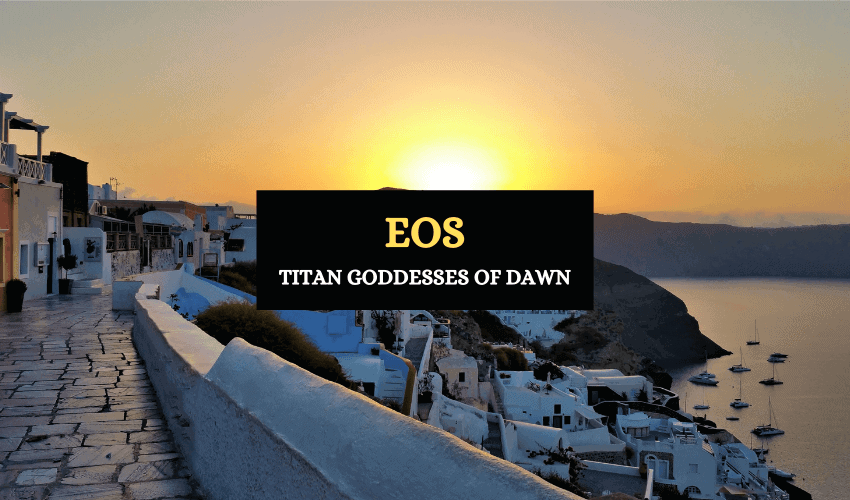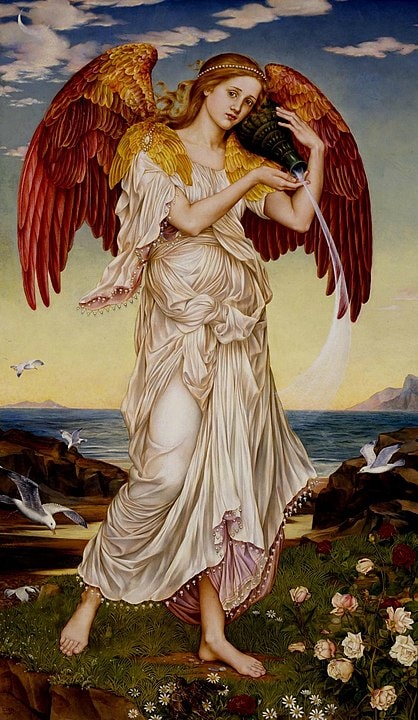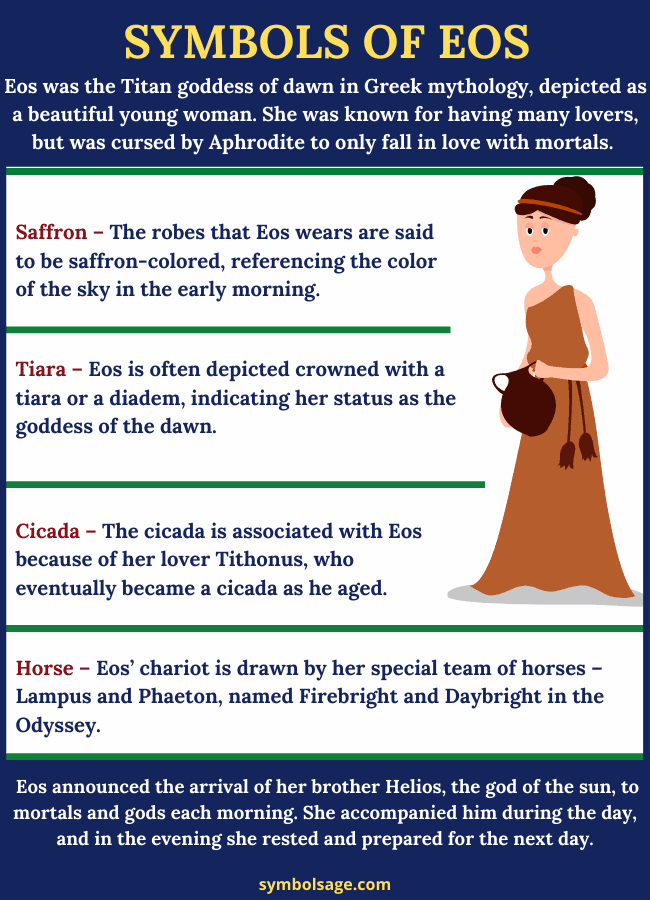
Table of Contents
In Greek mythology, Eos was the Titan goddess of the dawn who lived at the border of the Oceanus. She was said to have rosy forearms, or rosy fingers, and she awoke early every morning to open the gates of heaven so that the sun could rise.
Eos isn’t the most famous of deities in Greek mythology, but she did play a very important role by bringing light to the world each day.
Who was Eos Goddess?

Eos was a Titan of the second generation, born to Hyperion, the god of heavenly light and his wife Theia, the Titaness of sight. She was the sister of Helios and Selene, the personifications of the sun and the moon respectively. According to some sources, however, Eos’ father was a Titan called Pallas.
Eos and Astraeus
Eos was well known for her many lovers, both mortal and immortal. At first, she was linked with Astraeus, the god of dusk, who was also a second generation Titan like herself and closely associated with the planets and the stars. Together, the couple had many children including the Anemoi and the Astra Planeta.
Astra Planeta – the five gods who were personifications of the planets:
- Stilbon – Mercury
- Hesperos – Venus
- Pyroeis – Mars
- Phaethon – Jupiter
- Phainon – Saturn
The Anemoi – the Wind gods, who were:
- Boreas – the North
- Eurus – the East
- Notus – the South
- Zephyrus – the West
Eos was also famous as the mother of Astraea who was the virgin goddess of justice.
Eos as the Goddess of the Dawn
Eos’ role as the goddess of the dawn was to ascend up to heaven from Oceanus at the end of the night, to announce the coming of the sunlight to all the gods and mortals. As written in Homeric poems, not only did Eos announce the arrival of her brother Helios, the god of the sun, but she also accompanied him during the day until he was done traversing the sky. In the evening she would rest and prepare for the next day.
The Curse of Aphrodite
As already mentioend, Eos had many lovers, both mortal and immortal. Ares, the Greek god of war was one of her lovers but they never had any children together. In fact, their relationship didn’t get the chance to go too far.
When Aphrodite, the goddess of love, found out about the two, she was enraged, because she was also one of Ares’ lovers. Aphrodite was overcome with jealousy and she saw Eos as her competition. She wanted to get rid of her and so she cursed Eos so that she would only fall in love with mortals.
From that point onwards, Eos then began to be associated with the abduction of mortals she fell in love with.
- Eos and Orion the Huntsman
Orion was a legendary huntsman and was said to be Eos’ first mortal lover after she was cursed by Aphrodite. Orion was abducted by Eos and taken to the island of Delos, after he had regained his eyesight. In some versions of the myth, he was killed on the island by Artemis, the goddess of hunting, because she was jealous of him and Eos.
- Eos and Prince Cephalus
The story of Eos and Cephalus is another famous myth about her mortal lovers. Cephalus, the son of Deion and Diomede, lived in Athens and he was already married to a beautiful woman called Procris, but Eos chose to ignore this fact. She kidnapped him and the two soon became lovers. Eos kept him with her for a very long time and had a son with him, whom they named Phaethon.
Although Eos was in love, she could see that Cephalus wasn’t truly happy with her. Cephalus loved his wife, Procris and longed to return to her. After eight long years, Eos finally relented and let Cephalus return to his wife.
- Tithonus and Eos
Tithonus was a Trojan prince who was possibly the most famous of all Eos’ mortal lovers. Although they lived happily together, Eos was getting tired of all her mortal lovers leaving her or dying, and she was afraid that she’d lose Tithonus in the same way. She finally came up with a solution to her problem and asked Zeus to make Tithonus immortal so that he’d never leave her.
However, Eos made a mistake by not being specific enough when she made her request to Zeus. She forgot to tell him to give Tithonus the gift of youth. Zeus granted her wish and made Tithonus immortal, but he didn’t stop the aging process. Tithonus grew older with time and the older he got, the weaker he became.
Tithonus was much pain and Eos once again went to meet Zeus to ask his help. However, Zeus informed her that he couldn’t make Tithonus mortal or younger again so instead, he turned Tithonus into a cricket or a cicada. It’s said that in some parts of the world, the cicada is still heard every day at dawn.
In some variants of the story, Eos herself transformed her lover into a cicada, while in others he eventually became one, living forever but hoping for death to take him away. In other versions, she locked up his body in her chamber when he became too old but what exactly she did with it, no one knows.
Emathion and Memnon – Children of Eos
Eos and Tithonus had two sons, Emathion and Memnon, who later became the rulers of Aethiopia. Emathion was king first for a while but he attacked the demigod Heracles who was sailing up the River Nile one day. Heracles killed him in the fight that ensued.
Memnon was the more well-known of the two since he later played a part in the Trojan war. Dressed in armour made by Hephaestus, the god of fire, Memnon defended his city, killing Erechthus, the archaic king of Athens, and Pheron, the king of Egypt. Memnon was killed however, at the hands of the hero Achilles.
Eos was stricken with grief at the death of her son. The early morning light became less bright than it had been previously and her tears formed the morning dew. At Eos’ request, Zeus turned the smoke from Memnon’s funeral pyre into the ‘Memnonides’, a new species of bird. Every year, the Memnonides migrated to Troy from Aethiopia to mourn Memnon at his tomb.
Representations and Symbols of Eos

Eos is often depicted as a gorgeous young maiden with wings, typically holding a young man in her arms. According to Homer, she wore saffron-colored robes, woven or embroidered with flowers.
Sometimes, she’s depicted in a golden chariot rising from the sea and pulled by her two swift, winged horses, Phaethon and Lampus. Since she’s responsible for dispensing dew in the early morning, she is often seen with a pitcher in each hand.
The symbols of Eos include:
- Saffron – The robes that Eos wears are said to be saffron-colored, referencing the color of the sky in the early morning.
- Cloak – Eos wears beautiful robes or a cloak.
- Tiara – Eos is often depicted crowned with a tiara or a diadem, indicating her status as the goddess of the dawn.
- Cicada – The cicada is associated with Eos due to her lover Tithonus, who eventually became a cicada as he aged.
- Horse – Eos’ chariot is drawn by her special team of horses – Lampus and Phaeton, named Firebright and Daybright in the Odyssey.
Facts About Eos
Eos was the goddess of the dawn.
No, Eos was a Titan goddess.
Her parents are Hyperion and Theia.
Eos had many lovers, both mortal and god. Astraeus was her husband.
Because Eos had an affair with Ares, Aphrodite’s lover, she was cursed by Aphrodite to only fall in love with mortals and suffer them aging, dying and leaving her.
Eos’ symbols include saffron, horses, cicada, tiara and cloaks. Sometimes, she’s depicted with a pitcher.
In Brief
The story of Eos is somewhat tragic, in that she endured grief and faced many difficulties due to Aphrodite’s curse. Regardless, Eos’ story countless visual and literary works of art and she remains an intriguing figure. In some parts of Greece, people continue to believe that Eos still wakes before the night ends to bring forth the light of day and returns to her domain at sunset with a cicada for company.








